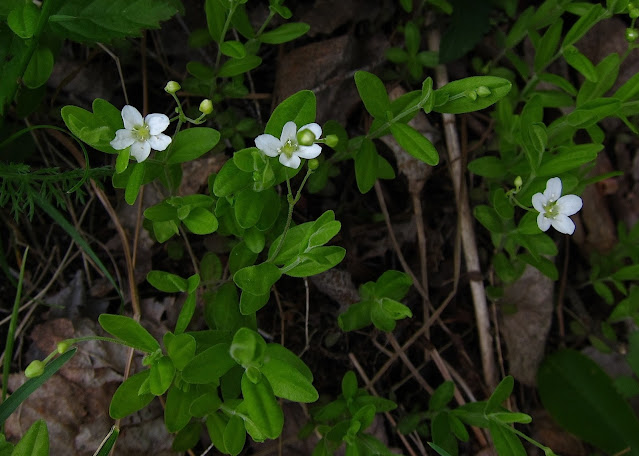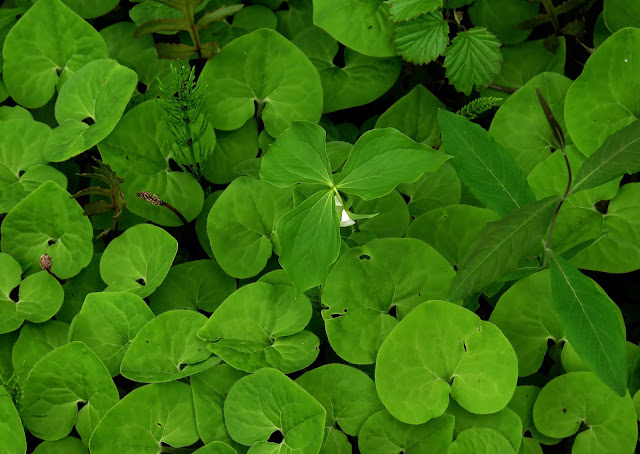I often think that Bog Meadow Brook Nature Trail in Saratoga Springs is kind of mis-named, since there's really only a tiny portion of this two-mile trail that's actually the kind of acidic, sphagnum-lined wetland that might properly be called a "bog." Most of this trail is bordered by shaded forested wetlands of varying pH and sunnier shrubby wet meadow, with creeks either rushing or ambling alongside, and three sections of open marsh. All parts of the trail provide marvelous habitat for a wide variety of native wildflowers and birds, but to me, the richest trove of wildflower treasures can be found in the trail's mid-section that's mostly pure swamp, densely wooded and wet underfoot, except for the raised main trail that once underlaid railroad tracks. This very convenient boardwalk, accessed from a housing development, brings me right into the center of Bog Meadowbrook Nature Trail without sinking up to my ankles in muck.

This boardwalk grants me easy viewing of a marvelous mix of swamp-loving plants, like this broad-leaved Skunk Cabbage, lime-green Sensitive Fern, and lacy-branched Wood Horsetail.
Fallen trees support many species of mosses, and colorful flowers like Wild Geranium and ferns like these dark-stalked Lady Ferns add beauty and textural variety.
The Wild Geranium flowers ranged in color from a near-white pale lavender to this more vivid purple.
Three different species of horsetails thrive along the boardwalk, including these two, Field Horsetail (right) with non-branching leaves and the lacier-looking Wood Horsetail, with dividing leaves.
To find the third species, the minute squiggly-stemmed Dwarf Horsetail, I had to sweep aside some of those broad Skunk Cabbage leaves to locate this ground-hugging curling mass, two of its stems now topped with spore-producing strobili.
To find a fourth species of horsetail, I had to walk further along Bog Meadow's main trail to where I found standing water, the habitat required by the aptly-named Water Horsetail, with its tall slender stalks bearing whorls of leaves. (A fifth species, Scouring Rush, grows in sunnier sections of the trail.)
In each population of Water Horsetail, only a few specimens bear the spore-producing strobili atop the branching stalks.
Also seeking wet habitat, as its name implies, is Water Avens, an attractive plant if you bend down low and peek at its pale-yellow petals held close within deep-red sepals (are they sepals?).
I was delighted that the dark water of a tiny stream served as a backdrop for this cluster of Two-leaved Miterwort growing right at the edge of the stream. The Miterwort's delicate snowflake-like florets would disappear against a busier background, they are so small.
Here's a closer look at those tiny Miterwort florets.
There's no chance I would miss seeing the bright-yellow clusters of Golden Ragwort blooms, standing out so luminously against the other tall plants that share its wooded wetland.
I might miss seeing these tiny flowers of Hooked Crowfoot, though, if the flowers were not so bright. It does take a close look to notice the little hooks on each ovary that suggested this wetland buttercup's name.
Here's a closer look at those tiny hooks, this plant's way of grabbing onto your pants for seed distribution purposes when ripe:
I did not have to LOOK for this Early Azalea shrub, even though it was blooming quite a ways off the trail, well back in the trailside swamp. I could detect its nearby presence just by its fragrance wafting on the air. Then, its vividly colorful blooms were easily discerned amid the thick shrubbery that surrounded it. To approach it for this photo, I had to avoid grabbing Poison Sumac trees to not topple as I teetered my way atop tussocks.
At last, I arrived at the only part of this trail that might be called "bog," a Sphagnum Moss-lined pool nearly covered with the three-parted leaves of Bog Buckbean. Sadly, almost all of its bright-white flowers had already fallen, except for an occasional remnant of bloom too far away for me to get a clear photo. (Since this pool is actually fed by a stream, though, it might more accurately be called a "fen.")
Here's a clearer photo of the now-fallen flowers, taken on another year on this same date, when every Bog Buckbean plant in this pool bore clusters of snowy five-parted blooms that were lined with squiggly hairs.
For the rest of my walk today, I kept to higher and drier ground along this preserve's main trail, observing some of Spring's prettiest forest-floor flowers. Many Canada Mayflower plants bore clusters of small white fragrant flowers.
Foamflower also bore similar clusters of starry white florets held on strictly erect stalks. The heart-shaped leaves help to distinguish this native wildflower from the Canada Mayflowers.
Here's another photo of dainty Foamflower and its pretty leaves. We once called this species by the scientific name Tiarella cordifolia, but taxonomists have recently decided that our local Foamflowers are actually the species stolonifera, due to its underground networks of stolons. The species cordifolia grows in more southern states than ours.
Low-growing plants of Dwarf Raspberry each held a single white-petaled bloom, which later will produce a single beautiful berry, translucent and ruby-red.
I am rarely able to get a photo of Wild Sarsaparilla that includes both its three stalks of compound leaves and the orbic clusters of tiny white flowers that grow on separate stalks beneath the leaves. Today was my lucky day!
The trail was lined with many Starflower plants, each bearing the lovely white star-shaped flowers that suggested its name.
There were several patches of Perfoliate Bellwort, each plant bearing a single nodding pale-yellow flower and with leaves that appeared to be pierced by the stems.
A look inside each Perfoliate Bellwort bloom revealed the granular dots that help to distinguish this species from one other species of bellwort that also has perfoliate leaves.
Just before I turned around to retrace my steps, I encountered an extensive patch of Star-flowered False Solomon's Seal, each plant bearing a terminal cluster of small starry-white florets. When I first encountered this lovely wildflower along this trail more than 12 years ago, I counted 10 specimens, all confined to a grassy area beneath a large White Pine. Today, there were more than a hundred in bloom, spread along the trail for a considerable distance, far from that original site.
Striding more quickly now along a portion of trail densely shaded by giant White Pines, I drew to a halt when I spied the vividly patterned basal leaves of Downy Rattlesnake Plantain spreading among the pine needles. This native orchid won't bloom until later in summer. If it blooms at all. Some years I find many of its erect multi-flowered stalks, and other years none at all. That's orchids for you. Fickle.
I did see many ferns today, in various stages of maturity: Cinnamon Fern, Interrupted Fern, Christmas Fern, Marginal Wood Fern, Royal Fern, Lady Fern, and this one I love best of all: the circling fronds of Maidenhair Fern. Those other ferns grow either singly or in small groups, but Maidenhair Fern, when it finds the lime-rich soil it requires, will often completely cover a bank with its trembling fronds that just seem to shimmer, even when not moving at all. So beautiful! Like so much else along this swampy stretch of Bog Meadow Brook Nature Trail.






















































